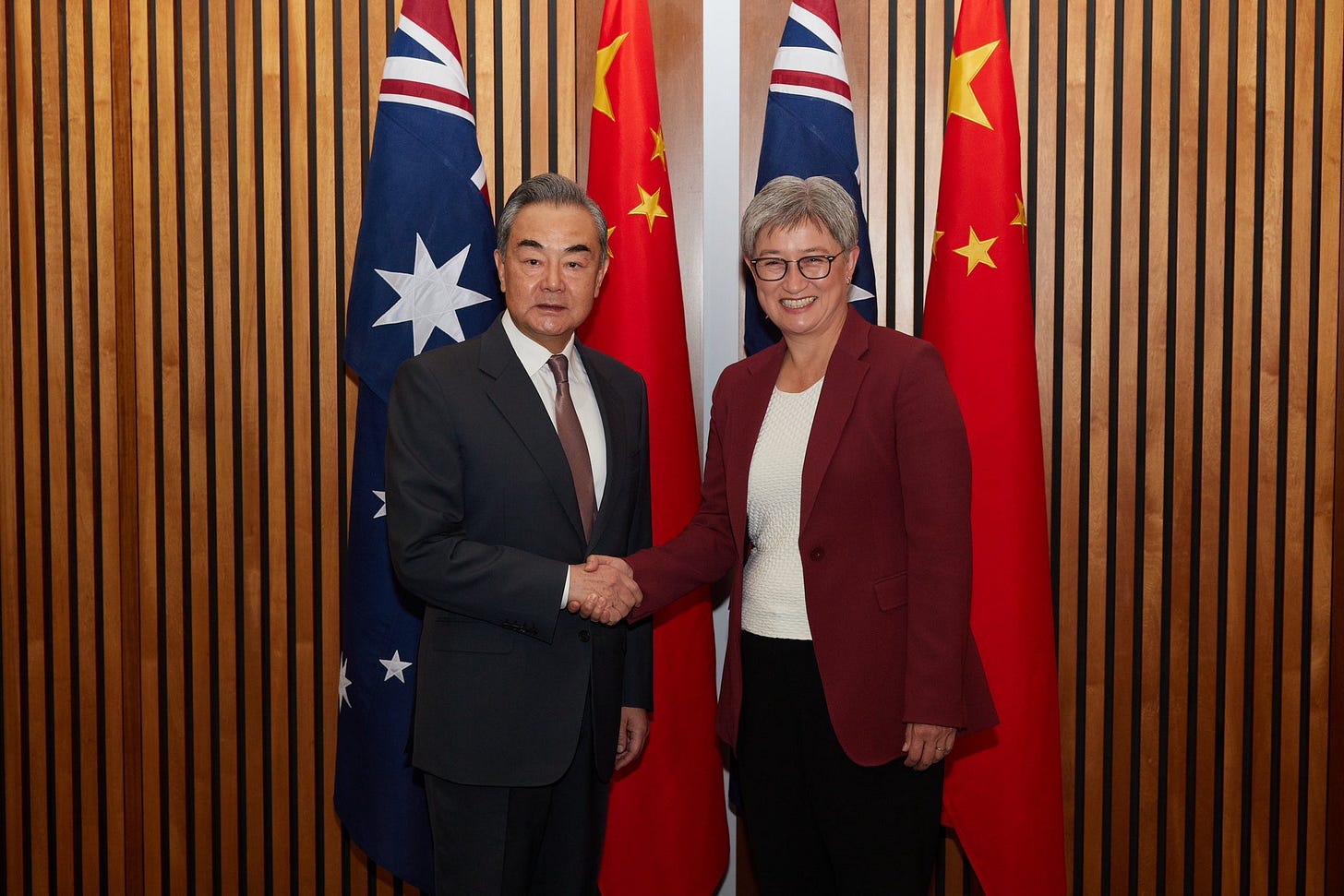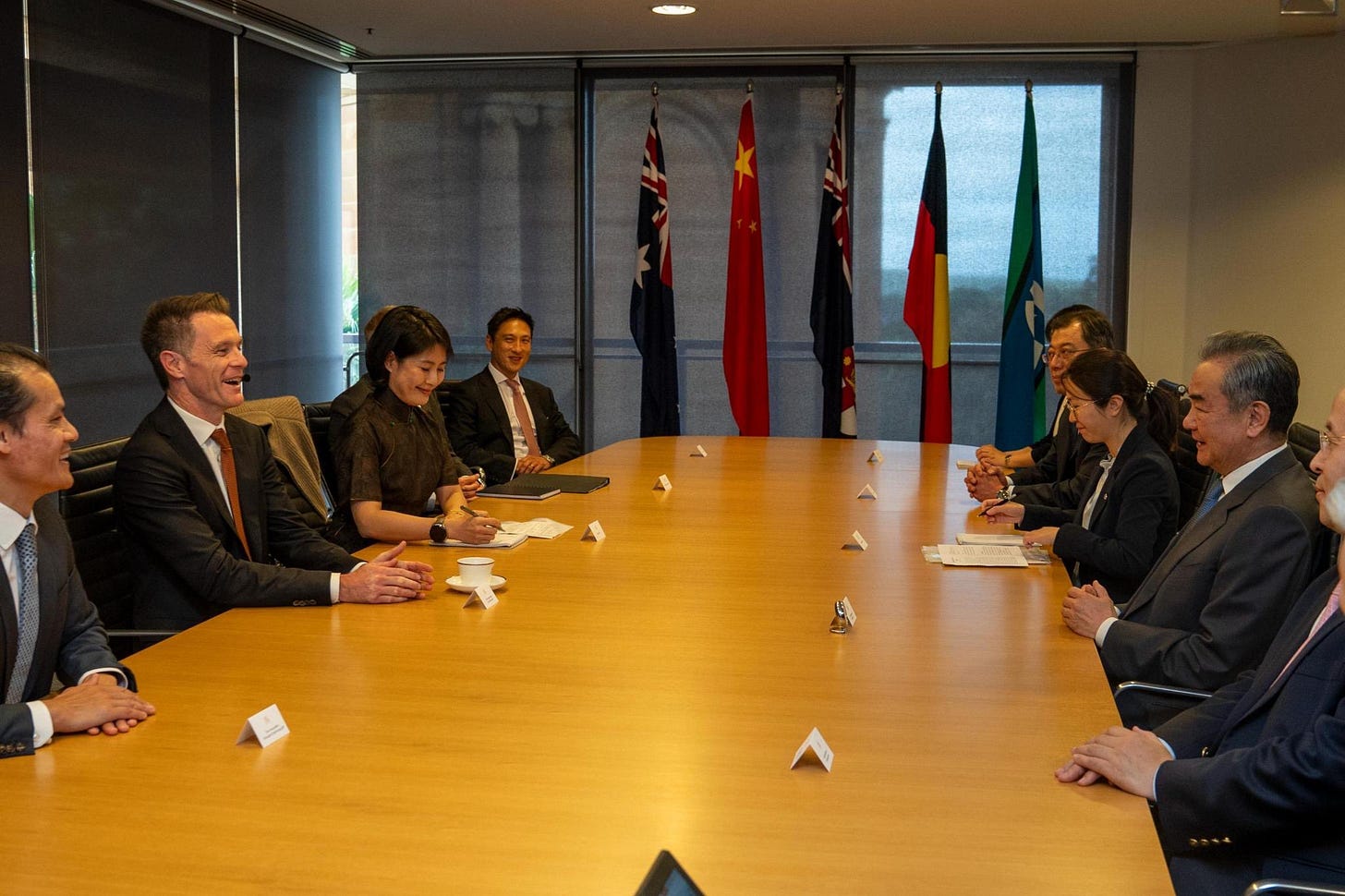A ministerial meeting, next steps in relationship repair, and stabilisation Vs. normalisation
Weeks of 4 to 24 March 2024
This is the free fortnightly(-ish) BCB newsletter. For readers looking for breaking analysis of major bilateral developments, BCB now also offers a paid subscription add-on. BCB in Brief provides quick assessments of the latest stories shaping the Australia-China relationship. You can upgrade to a paid subscription here:
Australian and Chinese foreign ministers meet
Minister for Foreign Affairs Penny Wong addressing her Chinese counterpart Wang Yi in Canberra on 20 March:
“You and I … agreed on the importance of dialogue between our two countries, not just to take forward our shared interests, but also to exchange views on the issues that matter to us and to navigate wisely, any differences we have.”
Quick take:
This trip made Minister of Foreign Affairs Wang the most senior Chinese government visitor to Australia since March 2017 when then Premier Li Keqiang came. This was also the first time in roughly as long that the Australian government hosted the Australia-China Foreign and Strategic Dialogue, which was in its 7th iteration. Although there might not have been any big-ticket announceables coming out of the meeting, it nevertheless canvassed a broad range of substantive bilateral issues. These included pointy disputes over Yang Hengjun’s suspended death sentence and geopolitical tensions in the South China Sea and Taiwan Strait, as well as shared economic and security interests.
Beyond the Foreign and Strategic Dialogue, Minister Wang’s visit featured a busy schedule of engagements. In addition to Prime Minister Anthony Albanese, Minister Wang met senior opposition politicians, other members of federal Parliament, prominent business and think-tank figures, New South Wales Premier Chris Minns, and former Prime Minister Paul Keating. Keating was strongly criticised in some quarters for taking the meeting and this get together prompted much speculation about Beijing’s motives and what it might reveal about China’s diplomatic nous or lack thereof. Despite the uncertainty surrounding the most apt interpretation of the Keating-Wang meeting, the rest of the packed visit again underscores China’s apparent keenness to rekindle ties with Australia. Beijing seems intent on reaching out to and reengaging with a wide spectrum of Australian political, business, intellectual, and community stakeholders.
Are there limits to this effort? Absolutely. Among other lacunas, Minister Wang didn’t engage openly with the Australian media or (so far as I’ve seen publicly) crossbench parliamentarians and think-tanks that are typically critical of China. It’s also unclear whether this broad-based reengagement with Australia will be successful. It’ll likely take much more than this visit and somewhat sunnier Chinese diplomacy to counteract the deep and enduring political, official, and public distrust of China in Australia. Even so, Wang’s hectic itinerary in Australia seems to again suggest that Beijing is undaunted by Australian misgivings and remains intent on pursuing its recently articulated ambition for an expanding cooperative agenda that progresses the relationship “beyond stabilisation.”

The next steps in Australia-China relationship repair
Minister for Trade and Tourism Don Farrell speaking on 16 March:
“We are very confident that … by the end of the month Australian wine can freely go back into the Chinese market.”
Quick take:
Despite its historic significance, the visit by Minister Wang is likely to be just one in a long series of steps towards relationship repair in 2024. On the trade front, the meeting between ministers Wong and Wang is all but certain to be followed by the removal China’s duties on Australian wine. As hinted by numerous signals (here, here, here, here, here, here, here, here, here, and here), this is likely to occur within days (as of time of writing on 27 March) so as to head off Australia recommencing dispute proceedings in the World Trade Organization. Minister Wong’s pre- and post-meeting positivity and other official signals indicate that the removal of the wine duties is likely to be followed in the coming months by the dismantling of trade barriers on lobster and beef. It therefore seems likely that all remaining trade restrictions will have gone before China’s Premier Li Qiang visits later this year, which judging by media speculation and Prime Minister Albanese’s recent comments could occur as early as June.
The repair of the Australia-China trade relationship is also likely to be accompanied by a further ramping up of political and diplomatic ties. It seems probable that Minister Farrell will host his Chinese counterpart Minister of Commerce Wang Wentao in the coming months, potentially in South Australia’s Clare Valley wine district where his family’s vineyard is located. This visit might precede Premier Li’s trip and Australia hosting the 9th iteration of the Annual Leaders’ Meeting, which the Australian government hasn’t done since March 2017. The possible Farrell-Wang meeting might also coincide with or follow an announcement about the removal of the trade barriers on lobster and/or beef.
This year is also likely to see the resumption of some additional bilateral diplomatic formats. Having been flagged as part of the outcomes of Prime Minister Albanese’s China trip in November last year, the Australia-China Strategic Economic Dialogue is likely to resume this year after a hiatus since 2017. Given shared bilateral interests in reducing carbon emissions and transitioning to greener energy, it also seems possible that the Australia-China Ministerial Dialogue on Climate Change will restart after having been put on ice in 2014. So, even if the Australia-China Human Rights Dialogue doesn’t return, most formal diplomatic engagement will be back online by the end of 2024.

Is the Australia-China relationship stabilising or normalising?
Prime Minister Albanese speaking to Weekend Sunrise on 16 March:
“[The Chinese Ministry of Commerce’s interim draft determination outlining a proposed removal of duties on Australian wine is] a product directly of the work that my Government has done to normalise, stabilise the relationship with China, to recognise the importance of that economic relationship.”
Quick take:
For a range of good analytical and political reasons, the Albanese government doesn’t usually talk about a reset or normalisation of bilateral ties. The relationship isn’t going back to the way it was during the arguable high point of 2014-15 when President Xi Jinping addressed the Australian Parliament, the bilateral free trade agreement was agreed and came into force, and ties were upgraded to a Comprehensive Strategic Partnership. In particular, we’re unlikely to ever return to the effusive positivity of November 2014 when President Xi spoke in Canberra of “the vast ocean of goodwill between China and Australia.” But while relations overall might have become gloomier since then, the trade, political, and diplomatic aspects of the bilateral relationship appear to be normalising—at least in the minimal sense of a progressive resumption of trade flows unimpeded by economic coercion and (for the most part) the return of the regular rhythm of high-level contact.
So, even though we shouldn’t ignore all the new and enduring sources of bilateral tension, I do wonder whether the Albanese government will soon push past its reticence to talk about relationship normalisation. Minister for Foreign Affairs Wong is likely wise to warn against fostering the expectation that the relationship is “going back to something.” And yet Prime Minister Albanese’s 16 March comment could be interpreted as an indirect acknowledgement of the growing range of trade, political, and diplomatic metrics that point to modest relationship normalisation in the form of a return to generally unrestricted trade and open diplomatic channels. To be clear, Prime Minister Albanese quickly caught his deviation from the talking points and amended his verboten “normalise” to the politically acceptable “stabilise.” Nevertheless, I wouldn’t at all be surprised if “normalise” is a word that we start hearing more regularly from Canberra in the coming months.
As always, thank you for reading, and please excuse any errors (typographical or otherwise). Any and all objections, criticisms, and corrections are very much appreciated.



